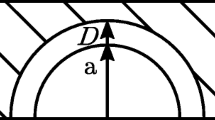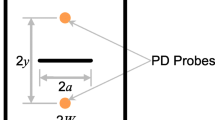Abstract
The dc potential drop technique can be used in conventional creep tests for high sensitivity measurements of deformation and damage. More importantly, it can be used in creep tests of notched specimens to: measure load creep deformation and damage at the root of the notch; detect crack initiation at the root of notches; and measure crack propagation rates, when the crack grows axisymmetrically.
This test methodology is well-suited for testing new alloys. The effects of heat treatment, environment, temperature, and specimen geometry on deformation rates, crack initiation, and crack propagation, can now be assessed in a quantitative way.
Similar content being viewed by others
References
J. Henderson and B.F. Dyson, “Multiaxial Creep Testing in Measurements of High Temperature Mechanical Properties of Materials,” Prof, of Symp., Eds. M.S. Loveday, M.F. Day and B.F. Dyson, NPL, Teddington, 1981, p. 171.
A.K. Schneider in Current Work on Behavior of Materials at Elevated Temperatures, ASME Winter Annual Meeting, 1974, ed. A. Schaefer, New York.
D.R. Hayhurst, F.A. Leckie and C.J. Morrison, “Creep Rupture of Notched Bars,” Proc. R. Soc. London, A 360, 1978, p. 243.
D.R. Hayhurst and J.T. Henderson, “Creep Stress Redistribution in Notched Bar,” Int. J. Mech. Sci., 19, 1977 p 133
D.R. Hayhurst, P.R. Dimmer and C.J. Morrison, Phil. Trans. R. Soc. London, A311, 1984, p. 103.
R. Matera and R. Rustichelli, “The Evaluation of Creep Damage in Creep of Engineering Materials and Structures,” Proc. Conf, ISPRA Italy, 1978, p. 389.
G. Belloni, G. Bernasconi, and G. Patti, “The Evaluation of Creep Damage in Creep of Engineering Materials and Structures,” Proc. Conf, ISPRA Italy, 1978, P. 195.
G.B. Thomas and H.R. Tipler, “Changes in Electrical Resistance During Creep of Cr-Mo-V Steels,” NPL Report DMA 74, NPK 7/05, September 1971.
R.P. Gangloff, “Electrical Potential Monitoring of the Formation and Growth of Small Fatigue Cracks in Embrittling Environments,” Advances in Crack Length Measurement EMAS, ed. C.J. Beevers, 1982, p. 175.
T.A. Prater and L.F. Coffin, “Experimental Cycle Analysis of Fatigue Crack Growth in Compact Type Specimen Geometries,” General Electric Co., Report #82CRD039, Feb. 1982.
M.A. Ritler and R.O. Ritchie, “On the Calibration, Optimization and Use of dc Electrical Potential Methods for Monitoring Mode III Crack Growth in Torsionally-Loaded Samples,” Fatigue of Eng. Mater, and Struct., Vol. 5, No. 1, 1982, p. 91.
P.K. VenKiteswaran and D.M.R. Taplin, “The Creep Fracture of Inconel X-750 at 700°C,” Met. Sci., 8, 1974, p. 97.
B.F. Dyson and D. McLean, “A New Method for Predicting Creep Life”, Metal Science Journal, 6, 1972, p. 220.
Additional information
Ioannis P. Vasatis received his B.S. in metallurgy from the National Technical University of Athens. He is currently a graduate student at M.I.T. completing his Ph.D. in metallurgy in the Department of Materials Science and Engineering under the supervision of Professor Pelloux.
Regis M. Pelloux received his Sc.D. in metallurgy from M.I.T. He is currently Professor of Materials Engineering in the Department of Materials Science and Engineering at M.I.T. Dr. Pelloux is also a member of TMS.
Rights and permissions
About this article
Cite this article
Vasatis, I.P., Pelloux, R.M. dc Potential Drop Technique in Creep Stress Rupture Testing. JOM 37, 44–49 (1985). https://doi.org/10.1007/BF03258768
Published:
Issue Date:
DOI: https://doi.org/10.1007/BF03258768




